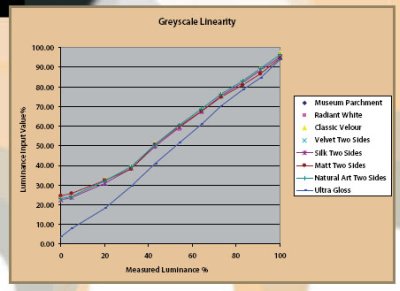articles/Paper/lumijetpreservation-page2
Paper Chase - Lumijet Preservation and Portfolio - part 2 of 1 2
by Mike McNamee Published 01/04/2006

Metamerism is low for all the media with the exception of the Classic Velour, which turned in a value of 4.1ÄE Lab. At the other end of the scale, the Matt 2-sided is as low a value as we have ever measured.
There is no detectable tonal cross-over along the greyscale, none of them drifts more than 2 ĢE points. The Classic Velour for example starts on the cream side of neutral, wanders a couple of points more yellow before returning to a paper match for the mid-tones and ends up just on the yellow side of neutral for the . tones and shadows. It is never more than 2 Lab points from the base neutral of the paper.
Book Making
Hahnemuhle produces the Lumijet papers pierced, with binding holes, so that they may be made up into "albums". These are not intended for the wedding album market but are an excellent and professional way for a photographer to present their portfolio. They could also be used to present a more lasting collection of commercial photographs for say a building-progress project, if you were trying to create a good impression with your client. The kit is thoughtfully provided with a few sheets of testing papers so that you can organise your printing and learn the direction that you should turn the paper to feed it to the printer for the reverse image. (see advert to the right)
Overall
These papers sit in a rather anomalous position in the Hahnemuhle paper range. They are not much less expensive than the other papers in their range but are light in weight. While this might be an advantage if you have to lug a big portfolio about, most users would prefer the meatier 300gsm variants from the actual Hahnemuhle range. However, for some applications the ability to auto feed sheet paper into a printer may be significant, especially if you have a lot of prints to make. The ability to do this without compromising the colour quality of the print may place the Lumijet range higher in your order of preferences than it might otherwise be. Apart from the slight translucency of the thinner paper you do not have to compromise on quality at all.
What happened to the canvas?
If you are wondering what happened to the canvas we spoke of earlier, we did attempt to make some test prints. However, sheet canvas and some printers are not a happy combination. The problem is the almost inevitable curl on the leading edge of a cut sheet. Sometimes this catches the print heads, resulting in smearing across the first couple of centimetres of the print. At its worst, the first pass of the print head causes lifting and (in our case) the second pass brings the head to a clattering standstill. It was such a bad crash in our case that we did not attempt any more printing. The problem is not confined to a particular product, we have had similar issues with other cut sheet and canvas. If the grain of the paper has been poorly oriented with the lay of the sheet you are in trouble, as the whole box will be a problem. It does mean that you should always store your paper flat (ie horizontal) as vertical or slanted storage will cause the weight of the paper to buckle it slightly. Gently bending the sheets back on themselves is a possible solution but not ideal as you should keep your greasy dabs off ink-jet surfaces as a matter of principle!
Please Note:
There is more than one page for this Article.
You are currently on page 2
- Paper Chase - Lumijet Preservation and Portfolio page 1
- Paper Chase - Lumijet Preservation and Portfolio page 2
1st Published 01/04/2006
last update 09/12/2022 14:56:13
More Paper Articles
There are 17 days to get ready for The Society of Photographers Convention and Trade Show at The Novotel London West, Hammersmith ...
which starts on Wednesday 14th January 2026





